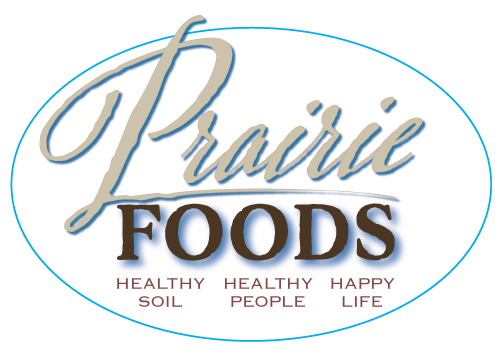The Six Soil Health Principles
posted on
July 11, 2025

These six principles, as taught by Understanding Ag, apply to every type of farm—whether you’re managing a 10,000-acre grazing operation, a conventional dairy, or a half-acre market garden. At Prairie Foods, we’ve built our grazing system around them. Here’s how we’ve applied each principle, and what we’ve learned along the way.
1. Know Your Context
Healthy soil is a reflection of good stewardship. Across the U.S., vast grasslands have been turned into lifeless dirt through poor management. Gabe Brown’s North Dakota farm is a powerful example: once reliant on synthetic fertilizer and irrigation, it's now a thriving ecosystem—even during drought—thanks to regenerative practices.
We believe context is foundational. Every farm is different, and knowing your context means understanding your land, your goals, and your family’s needs. For us, that meant perennial grasslands and grazing animals, not row crops and heavy equipment. We wanted a safe, peaceful farm environment where we could work alongside our children and build something sustainable for the next generation.
We also wanted to be profitable. That’s why we chose direct marketing—even though it’s a lot of work, it allows us to keep the value we create. It’s not the right path for everyone, but it fits our context. Regeneration must include not just soil health, but also relational and financial health.
2. Minimize Disturbance
Nature doesn’t till, spray, or disturb the soil without reason—and neither should we. While there are times mechanical or chemical inputs might feel necessary, we approach both with caution and clear purpose. The more we disturb the soil, the more life we lose.
Our decision to manage perennial grasslands means we don’t need to plant or terminate crops, and we never till. But even in cropping systems, farmers are proving that no-till, no-spray models can work. It just takes intentionality.
3. Keep the Soil Covered
Bare soil is losing carbon, losing moisture, and losing life. In cropping systems, farmers now use cover crops to ensure the soil stays protected even between plantings. Some even interplant cover crops into growing cash crops, minimizing gaps in ground cover.
In a grazing system, soil coverage takes just as much thought. Overgrazing and grazing too short exposes the soil and sets back microbial activity. That’s why we move animals frequently—often multiple times per day—and aim to graze only the tops of the grasses.
We also intentionally trample some grass to cover bare spots, creating a protective mulch layer. In the fall, we leave more residue behind and often feed hay early so we can rest the pastures through winter. If we can see soil in early spring, that’s a sign we didn’t leave enough.
This one shift—protecting the soil through fall and winter—has made a huge difference in both soil health and animal performance.
4. Encourage Biodiversity
Nature doesn’t do monocultures. Every healthy ecosystem is a symphony of plant, microbe, insect, and animal diversity. The same should be true in farming.
One reason we chose grass-based livestock production is because of the natural diversity it fosters. In a single summer afternoon, I found over 24 plant species in a small section of one field—many of which we didn’t plant. When grazed well, pastures become more diverse every year.
Animals benefit, too. Cows, like people, prefer variety. They instinctively select plants based on what their bodies need. We don’t want them standing at a bunk eating a pre-mixed ration—we want them foraging a dynamic salad bar.
We also mix up how we graze. Sometimes we use ultra-high stock densities with rapid moves; other times, we give more space and longer access. Some days, cows graze only old brown grass at night to trample it, and get fresh green forage by day. Rest periods vary from 20 to over 100 days. This variety stimulates plant growth, prevents overuse of any one species, and keeps the soil biology adapting.
Like athletes, soils and ecosystems get stronger through managed stress and variability—not repetition.
5. Keep Living Roots in the Soil
Soil biology depends on living roots. Plants feed the microbes that keep the soil alive. Without them, the biology starves.
This is one of the simplest principles for us to follow. Since we manage perennial pastures, our soils rarely go more than a day or two without living roots. It’s a big reason we believe so strongly in grass-fed livestock. Animals can live and thrive on pasture, and the soil thrives right alongside them.
6. Integrate Livestock
Livestock are essential to natural nutrient cycling. They’re part of how nature was designed to function. Wherever possible, animals should be returned to the land—not confined in buildings or limited to drylots.
Many regenerative crop farmers are now integrating dry cows or heifers into cover-cropped fields, reducing input costs and building soil at the same time. While it’s possible to regenerate soil without livestock, something vital is missing.
That’s why we graze animals. It’s also why we’ve chosen to focus on grass-fed meat, eggs, and dairy. There’s no easier or more elegant way to restore land than with animals on pasture. If more farms transitioned from row crops to regenerative livestock, we could retire millions of acres from intensive cropping and bring back grasslands.
That shift would restore the land and the health of the next generation.
These six principles aren’t just ideas—they’re tools. They guide the way we steward our land and our animals. And we’ve found that when we follow nature’s patterns, nature gives back in abundance.
The reality is that you go through all sorts of effort to source the best food possible for you and your family. You can optimize your shopping to an extent, but the most important aspect is finding farmers who raise animals to be the most nutrient-dense—and that starts with the soil.




